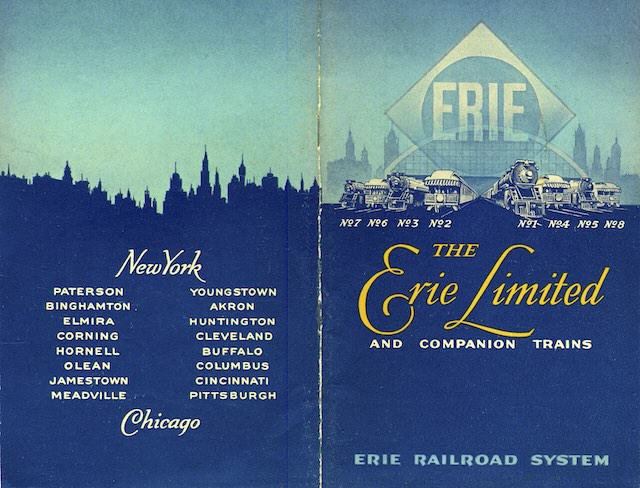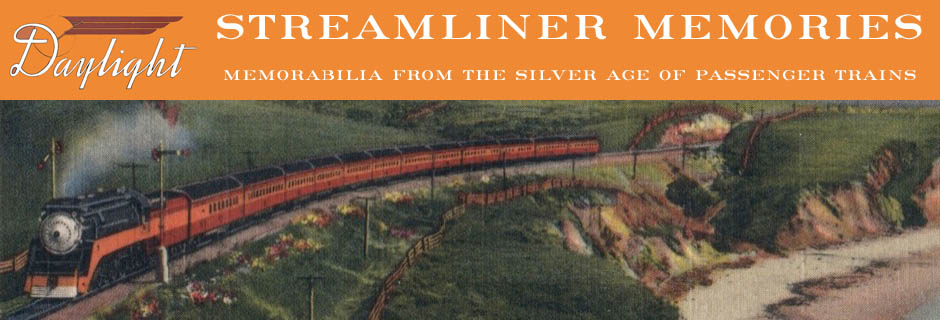This booklet introduces “the splendid new Erie Limited,” which was inaugurated on June 2, 1929. This train “provides 25 hour service at the lowest fares available.” The train in fact took slightly less than 25 hours to go between New York and Chicago, including the ferry ride between downtown Manhattan and Erie’s train station in Jersey City.
 Click image to download a 9.3-MB PDF of this 28-page booklet.
Click image to download a 9.3-MB PDF of this 28-page booklet.
While New York Central’s and Pennsylvania’s fastest trains, the 20th Century and Broadway, took only 20 hours in 1929, they charged an extra fare of $9.60 — about $175 in today’s money. At least five other NYC and six other PRR New York-Chicago trains charged extra fares as well.
According to Tim Zukas (scroll down the link to timz’s full comment), who has contributed many timetables to this and other web sites, “In the 1920s, the no-extra-fare schedule NY to Chicago was 28 hours. Lots of trains were faster; the passenger paid an extra $1.20 for each hour saved.” Considering that the average wage for unskilled workers was less than 45 cents an hour in 1929, $1.20 an hour was quite a premium for faster trains.
A 1929 timetable posted on an Erie-Lackawanna web site says that the Erie Limited also charged an extra fare but the timetable didn’t say how much (note: the PDFs on this web site appear to only be viewable in Adobe Acrobat). As a 25-hour train, if it followed the NYC and PRR practice of $1.20 per hour, the extra fare would have been $3.60, about $70 in today’s money. The 1929 timetable does say that Erie’s regular fare from New York to Chicago was $2 less than Pennsylvania’s ($30.70 vs. $32.70), which would have made up for some of the extra fare.
The new Erie Limited was not as luxurious as the 1929 North Western Limited that was described in a booklet presented here last month. The Erie train had an observation-lounge car, a diner, and the usual range of sleeping accommodations (berths, compartments, and drawing rooms) but not an entire car of compartments and drawing rooms.
The Erie Limited had a club-lounge for coach passengers that isn’t pictured in this booklet but an ad in the July 1929 timetable indicates it was more like a smoking car with no food or beverage services. Still, the train would have been quite adequate for people who could afford to travel by Pullman in the 1920s but not on premiere trains like the 20th Century Limited.
The booklet briefly mentions other Erie trains in the New York-Chicago corridor. The westbound Chicago Express took almost 27 hours, while the eastbound New York Express took nearly 28; the westbound Pacific Express and eastbound Atlantic Express each took more than 31 hours. These trains had diners and some had parlor cars for part of the distance but no observation or lounge cars.
Page 2 is a photo of one of “the giant locomotives [that] haul the Erie Limited.” It is a 4-6-2 at a time when many other railroads had graduated to 4-8-2s and 4-8-4s (neither of which Erie ever owned). The locomotive in the photo, number 2960, was delivered by Baldwin in 1926 as the last 4-6-2 ordered by the Erie. With 47,000 pounds of tractive effort, it was among the most powerful 4-6-2s ever built, but it had nowhere near the 55,000-60,000 pounds typical of many 4-8-2s much less the 65,000-70,000 pounds typical of many 4-8-4s. Erie’s other 4-6-2s had under 44,000 pounds of tractive effort.
